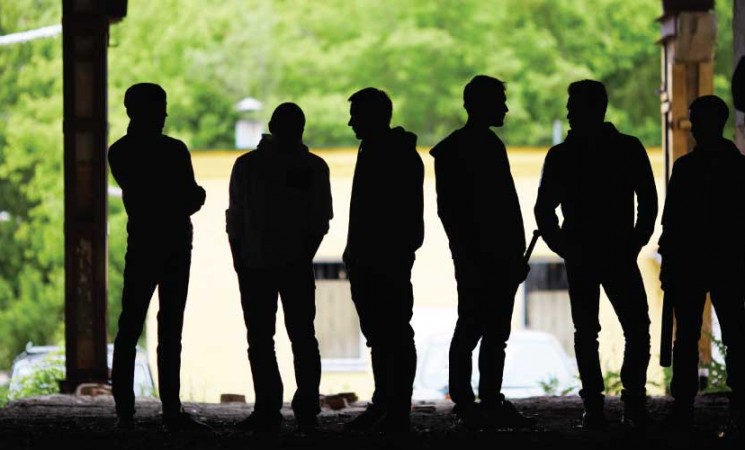Archived Content
This page is archived and provided for historical reference. The content is no longer being updated, and some of the information may have changed over time and could be outdated or inaccurate.

By David Pyrooz, Ph.D.
Gangs evoke clear images of certain people, places, and activities—racial and ethnic minority boys, prisons and inner cities, and health risk behaviors, such as violence, drug dealing, and weapon carrying. It is also thought the gang membership is a lasting commitment, or at least a commitment that exacts a physically costly toll to exit. Many media commentators and criminal justice officials feel that gangs are running rampant in our neighborhoods and schools. Are these stereotypes accurate?
In a recent study published in the Journal of Adolescent Health, my colleague Gary Sweeten and I sought to assess the accuracy of these claims. While many studies have explored the extent to which males and minorities are overrepresented in gangs, and how long youth remain in gangs, this research was city-specific rather than general to the United States. Our interests were in painting a national portrait of juvenile gang activity, which is what we did using data from the National Longitudinal Survey of Youth 1997 (NLYS97), representative of youth born between 1980 and 1984.
Patterns and demographics of gang members were tracked among juveniles in the U.S. between ages 5 and 17. Juveniles self-reported their involvement in gangs, including the age at which they joined and left the gang, and patterns of gang membership were tracked over the NLSY97 annual surveys. While there are reasons why youth might under- or over-report membership in a gang, this method of operationalizing gang membership has high reliability and validity. Based on extreme assumptions about missing data and sampling design effects, we placed upper and lower bounds over our estimates to represent the most and least conservative findings. We then linked these findings to demographic and socioeconomic data in the NLSY97 and extrapolated from the 2010 U.S. Census data to produce single age estimates.
Gang Membership in the U.S. Is Transient and Overwhelmingly an Adolescent Activity
Our study revealed several critical findings about juvenile gang membership in the U.S. First, the overall prevalence of gang membership was 2.0%, with extreme lower and upper bounds of 1.2–2.8%. These results suggest that gang membership is rare among youth. Second, gang membership is strongly age-graded. Age-specific rates of gang membership surpassed 1% by age 10, then rapidly increase during the pre-teen years, peaking at 5% at age 14. By the late teens, rates of gang membership drop back down to 1%. Should those trends persist through adulthood, it would suggest that gang membership is overwhelmingly an adolescent activity.
The third major finding from our study was that there are slightly over 1 million juvenile gang members in the U.S. This figure might sound exceptionally large, but findings from nationally representative surveys of law enforcement identify much fewer juvenile gang members. Our conservative lower bound estimate was 2.2 times as great as what law enforcement reports, suggesting that there are far more gang youth who go undetected in official records, which has tradeoffs that are both good (e.g., reduced risk of labeling) and bad (e.g., missed opportunity for intervention services).
Fourth, gang membership is a highly transient life state. Rarely did youth persist in gangs beyond one or two years. The annual turnover rate in gang membership was 36%—not quite equivalent to restaurant/hospitality industry rates, but youth join and leave gangs quite frequently. Indeed, our results showed that roughly 400,000 youth exited gangs annually. Which also means that gangs constantly had to attract new members, and our results showed that about the same number of youth joined gangs each year.
Finally, while gang members were disproportionately male, Black, Latino, from single-parent households, and families that lived below the poverty line, these demographic and socioeconomic characteristics were not monolithic to gang members. Many females, whites, and children from two-parent and middle- and high-income households were also gang members.
The results of this study are important for law enforcement and health care professionals. Law enforcement under-recognizes juvenile gang activity, which may be surprising to some who feel police practices do more to net-widen than to reduce criminal stigma. Yet, the powerful image of juvenile gang members promulgated by law enforcement is not entirely accurate, particularly with respect to gender, race, and ethnicity. Relying on law enforcement representations of juvenile gang members runs the risk of type II error.
Another important implication of these results is that they drive home calls for early prevention and intervention, both of which should be in place during the pre- and mid-teen years. Gang membership has lasting consequences that cascade across life domains, including economic, education, family, and health, which is why is it much more effective to prevent gang membership than having to intervene once a youth is active.
Note
This research was supported by the Office of Juvenile Justice and Delinquency Prevention (2011-JV-FX-0004). The content of this posting is the responsibility of the author and does not necessarily represent the official views of the U.S. Department of Justice.
About the Author
 David Pyrooz, Ph.D.
David Pyrooz, Ph.D.
David Pyrooz is Assistant Professor of Sociology at the University of Colorado Boulder. He is also Faculty Associate of the Problem Behavior and Positive Youth Development in the Institute of Behavioral Science. He received his Ph.D. in criminology and criminal justice from Arizona State University in 2012. His research interests are in the areas of gangs and criminal networks, crime trends and life course criminology, incarceration, and offender reentry. He was the 2015 recipient of the inaugural New Scholar Award from the Academy of Criminal Justice Sciences and the 2016 recipient of the Ruth Shonle Cavan Young Scholar award from the American Society of Criminology. More information can be found on his CU Boulder faculty webpage. Contact David Pyrooz via email ([email protected]) or on Twitter (@dpyrooz).
Photo Credit: Shutterstock/Pressmaster








